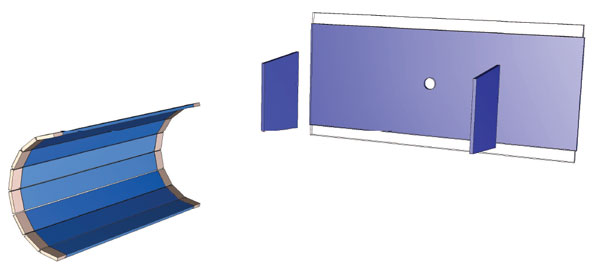Contact: Carsten Schwarz
In reactions with multi particle final states, at low beam energies, and
for backward emitted particles at high beam energies, the released
energies per particle are low. For the particle identification of slow
charged particles, for the DIRC detector, and for track deconvolution of
the TP-Chamber it becomes more and more clear, that a time of flight
barrel in the target spectrometer is desirable. It also increases
redundancy for other sub-detector systems. For the trigger of the
hypernuclei program the timing barrel allows to increase the detection
probability for xibars by a factor of up to 1000 by detecting the slow
kaon decay products.
In order to achieve low energy threshold, the barrel is located in front
of the radiator barrel of the DIRC and could also become mechanical
combined with the latter. For an assumed time resolution of σ=100ps,
one expects a three standard deviation π/K separation up to 430 Mev/c
at 90 degree and up to 760 MeV/c at a polar angle of 22 degrees.
For the hypernuclei physics program , where the secondary target is
displaced by 70cm upstream, these momentum thresholds raise up to 1 GeV/c.
For the DIRC subsystem, the TS-TOF barrel could serve as a time
reference for the timing information in addition to the coordinates of
the Cherenkov images. This timing information helps to reduce background
and allow to correct dispersion effects.
The optional time-projection chamber will also gain performance with the
fast timing information and a rough position information. It helps to
deconvolute the tracks,which are ``stored'' within the TPC volume due to
the long drift time of the electron clouds.
Two possible setups are foreseen: a scintillator barrel consisting of a
fast scintillator like BC408 or a barrel consisting of RPC counters.





